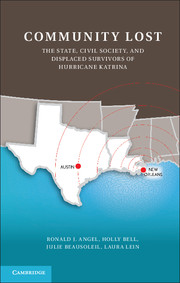Book contents
- Frontmatter
- Contents
- Acknowledgments
- Introduction
- 1 After the Storm
- 2 An Emerging Methodology for a Crisis Situation
- 3 Life before the Storm
- 4 Evacuation and Arrival in Austin
- 5 The Limited Transportability of Social Capital
- 6 Civil Society, NGOs, and the Grassroots Response
- 7 Housing, Employment, and Identification
- 8 Health Care and the Limitations of Civil Society
- 9 The State, Civil Society, and the Limitations of Social Capital
- Bibliography
- Index
3 - Life before the Storm
The Old Community
Published online by Cambridge University Press: 05 June 2012
- Frontmatter
- Contents
- Acknowledgments
- Introduction
- 1 After the Storm
- 2 An Emerging Methodology for a Crisis Situation
- 3 Life before the Storm
- 4 Evacuation and Arrival in Austin
- 5 The Limited Transportability of Social Capital
- 6 Civil Society, NGOs, and the Grassroots Response
- 7 Housing, Employment, and Identification
- 8 Health Care and the Limitations of Civil Society
- 9 The State, Civil Society, and the Limitations of Social Capital
- Bibliography
- Index
Summary
Before the storm most Americans knew New Orleans for Mardi Gras, the French Quarter, Bourbon Street, and the Jazz Festival. For tourists, the Big Easy offered a unique atmosphere of escape; it was a party town where visitors ate, drank, and listened to sultry music into the wee hours. The city was famous for its unique mix of French and African cultures, its gumbo and beignets, and its art and southern culture. For visitors, New Orleans offered diversions that they could enjoy for a limited time before returning home, but for those who called the city’s low-income neighborhoods home, New Orleans was a very different place. It evoked little of the mystery and charm that attracted outsiders. For the victims of Hurricane Katrina, the neighborhoods in which they lived consisted of familiar communities in which the residents had often lived for generations, but it would be a mistake to romanticize these communities. As our participants recounted to us, these neighborhoods were beset by problems of poverty, crime, poor housing, and inferior schools. Yet these areas were the familiar physical and social locations in which people were born, lived their lives, and died. The poverty and disorganization that characterized the poorest wards of the city required strong bonds of family, friends, and neighbors for basic survival. The loss of these communities and the strong social and family ties that characterized them represented a major loss. Rebuilding those communities and social ties, or even approximating them, in a new and unfamiliar city proved to be an extremely challenging task. As we show in this and later chapters, the attempt was frequently unsuccessful. Despite the assistance of many governmental and nongovernmental agencies and organizations, many individuals and families remained marginalized.
- Type
- Chapter
- Information
- Community LostThe State, Civil Society, and Displaced Survivors of Hurricane Katrina, pp. 55 - 79Publisher: Cambridge University PressPrint publication year: 2012



